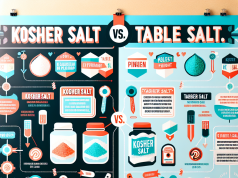Contents
The Art of Salt Milling: How to Properly Grind Salt for Optimal Flavor
Salt is a staple ingredient in cooking and adds flavor and depth to meals. However, not all salt is created equal, and the way you grind it can impact its flavor.
The art of salt milling lies in understanding the different types of salt and the optimal grind size for each. Fine-grain salt works well on foods with delicate textures, while coarse salt is better suited for heartier dishes.
Properly grinding salt also involves using the right equipment. A quality salt grinder or mill can provide consistent results and maintain the integrity of the salt’s texture and flavor.
Additionally, it’s important to consider the source of the salt. High-quality salts, such as Himalayan pink salt or sea salt, offer unique flavor profiles and mineral content that can enhance your dishes.
By mastering the art of salt milling, you can elevate your cooking and bring out the best flavors in your dishes.
The Art of Salt Milling: How to Properly Grind Salt for Optimal Flavor
Introduction
Salt is one of the most commonly used seasonings in the world. It enhances the flavor of food and brings out its natural taste. However, not all salts are created equal. There are many types of salt available, from table salt to sea salt to Himalayan salt. Each type of salt has a different texture and flavor profile, which can greatly affect the taste of your food. In this post, we’ll explore the art of salt milling and how to properly grind salt for optimal flavor.
The Importance of Salt Grinding
Many people don’t realize that how you grind salt can greatly affect the taste of your food. Salt is composed of small crystals, and the size of those crystals can affect how fast the salt dissolves and how much of it is absorbed into the food. When you use large crystals of salt, they take longer to dissolve and can leave a gritty texture on your food. On the other hand, finely ground salt dissolves quickly and evenly, resulting in a more even flavor distribution. Additionally, salt that is ground too finely can become too compact and difficult to sprinkle evenly over food.
The Different Types of Salt Mills
There are many different types of salt mills available, each with its own unique features. Here are the most common types:
- Manual salt mills: These are handheld mills that require you to twist a knob or turn a handle to grind the salt. They come in many different designs and are often made of wood, plastic or metal. Manual mills are great for those who want to have more control over the grinding process, but they can be tiring to use if you need a lot of salt.
- Electric salt mills: These are powered by electricity and require the push of a button to grind the salt. They are much easier to use than manual mills and are great for people who need to grind a lot of salt quickly. However, they are often more expensive than manual mills.
- Traditional mortar and pestle: This is a non-mechanical way of grinding salt. It’s great for those who prefer a more hands-on approach to cooking. However, it can be time-consuming and can result in uneven grinding.
The Best Salt for Grinding
The best type of salt for grinding is a coarse sea salt. Coarse sea salt has large crystals that are perfect for grinding, and it dissolves quickly and evenly. Avoid using table salt, since it has a fine texture and anti-caking agents that can affect the taste of your food. Himalayan pink salt is another great option, since it has a unique flavor profile and a beautiful pink color.
Tips for Grinding Salt
If you’re new to salt grinding, here are some tips to keep in mind:
- Start with a small amount of salt in your mill, since grinding a large amount can be time-consuming and tiring.
- Use a steady hand and apply even pressure when grinding the salt.
- Avoid grinding salt over a hot pot or stove, since the moisture can cause the salt to clump.
- Store your salt in a dry place, such as a pantry or cupboard, to prevent it from absorbing moisture and clumping.
- Clean your salt mill regularly to prevent it from clogging and to ensure that the salt tastes fresh.
Conclusion
Salt grinding may seem like a small detail in the cooking process, but it can greatly affect the taste and texture of your food. By choosing the right type of salt mill and using the proper technique, you can enhance the flavor of your dishes and elevate your cooking game. So the next time you reach for the salt, consider giving it a grind and see the difference it makes!
For more information on the different types of salt, visit healthline.com.
The Art of Salt Milling: How to Properly Grind Salt for Optimal Flavor
Why is it important to grind salt?
Grinding salt helps to release its natural flavors and aromas, which can enhance the taste of your food. It also allows for better control over the amount of salt that is used in a dish, as well as the texture and size of the salt crystals.
What type of salt should I use for grinding?
It is recommended to use coarse sea salt or kosher salt for grinding. These types of salt have larger crystals, which make them easier to grind and provide a more consistent texture.
What is the best type of salt mill to use?
A ceramic or stainless-steel mill is recommended, as these materials are less likely to corrode over time. It is also important to choose a mill with adjustable settings so that you can achieve the desired level of coarseness for your salt crystals.
How do I clean my salt mill?
It is important to clean your salt mill periodically in order to prevent any buildup of salt or other debris. Simply disassemble the mill, remove any remaining salt, and wash the parts with warm, soapy water. Allow the mill to dry completely before reassembling and using again.
Salt Mill: The Ultimate Solution to Grind Your Salt Perfectly
Are you tired of having an uneven distribution of salt on your food? Then a salt mill is what you need! A salt mill is a device that grinds salt crystals into smaller pieces, resulting in a fine or coarse texture that evenly distributes salt onto your food. Not only does a salt mill enhance the taste of your food, but it also adds an appealing look to your table.
Types of Salt Mills
There are various types of salt mills available in the market. Each type has its own unique features and functionality. Adjustable salt mills allow the user to adjust the grind size of the salt particles, while electric salt mills require batteries or electricity to operate. Other salt mills come in different sizes and designs with either manual or automatic grinding options.
Finding the Right Salt Mill
When looking for a salt mill, consider factors such as size, material, ease of use, and maintenance. Stainless steel salt mills are durable and easy to clean, while wooden salt mills add an organic feel to your kitchen. Also, look for salt mills with adjustable settings to easily switch between fine and coarse grains.
Conclusion
A salt mill is an essential tool for any kitchen if you want to add perfectly ground salt to your meals. With different options to choose from, finding the right salt mill can elevate your meal experience. Give your meals the perfect finishing touch with a salt mill today!
To learn more about salt mills, check out Wikipedia’s page on Pepper Grinders
The Art of Salt Milling: How to Properly Grind Salt for Optimal Flavor
Why Grind Your Own Salt?
- Better flavor and texture
- Ability to customize coarseness
- Avoidance of additives and preservatives
Types of Salt to Grind
- Sea salt
- Himalayan pink salt
- Kosher salt
Choosing a Grinder
- Manual vs. electric
- Burr vs. blade
- Adjustable coarseness settings
Grinding Techniques
- Hold the grinder properly
- Apply even pressure
- Grind in a consistent motion
Storage and Maintenance
- Store in a dry place
- Clean regularly to avoid buildup
- Use high-quality salt for best results







































